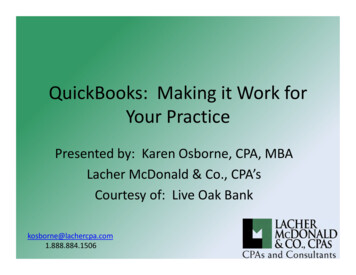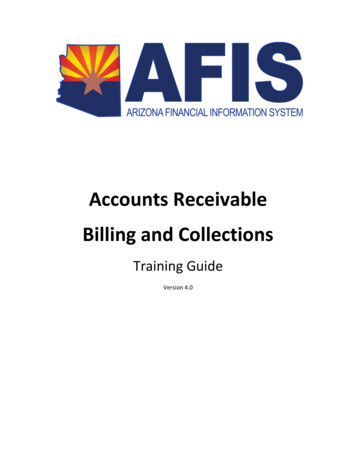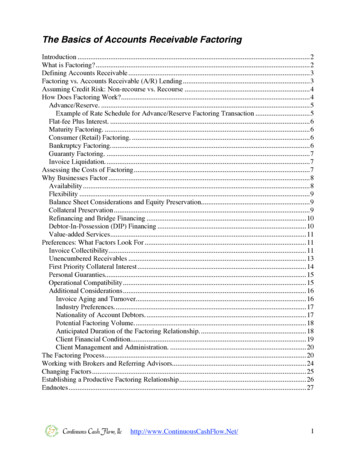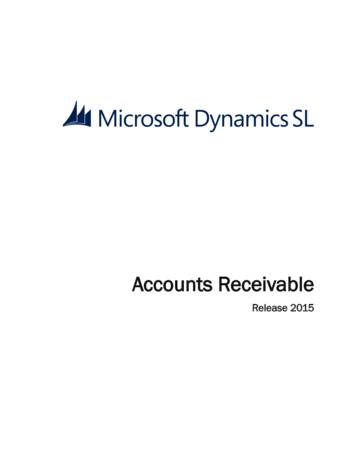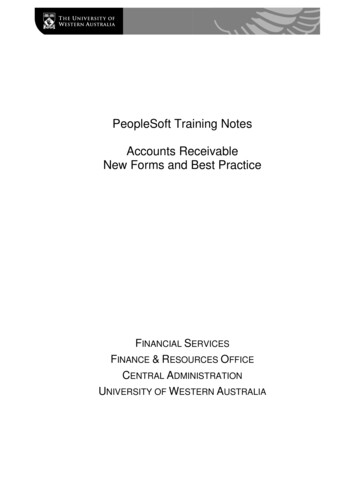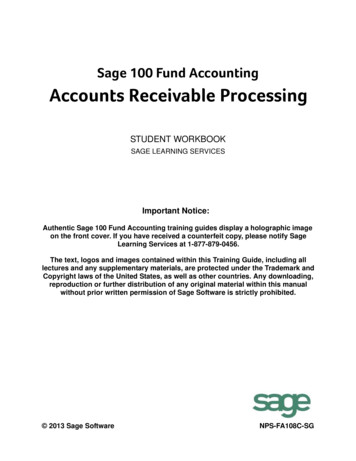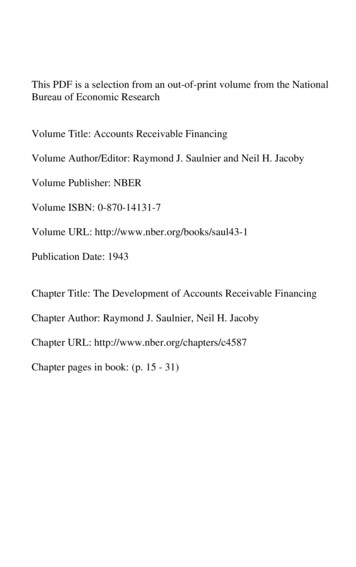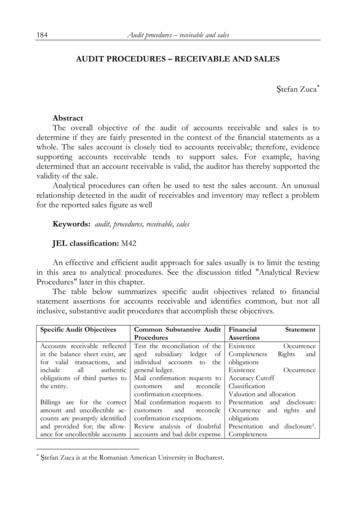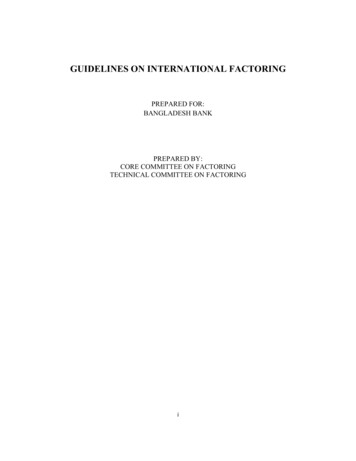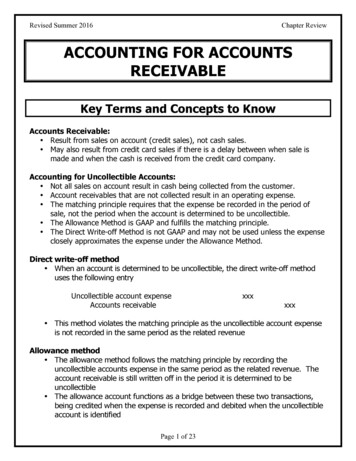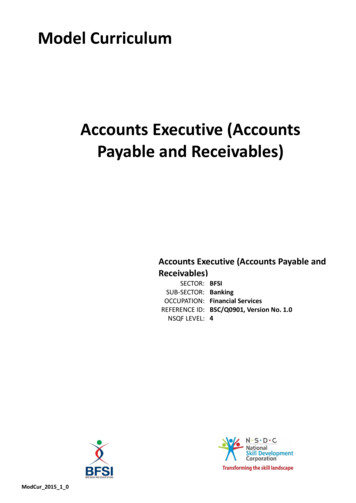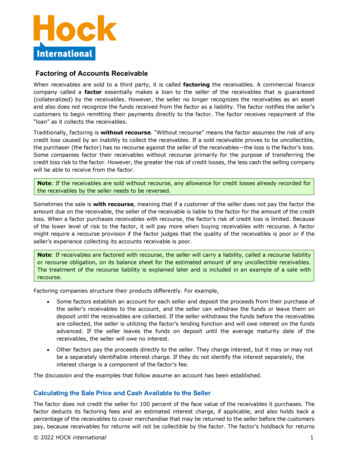
Transcription
Factoring of Accounts ReceivableWhen receivables are sold to a third party, it is called factoring the receivables. A commercial financecompany called a factor essentially makes a loan to the seller of the receivables that is guaranteed(collateralized) by the receivables. However, the seller no longer recognizes the receivables as an assetand also does not recognize the funds received from the factor as a liability. The factor notifies the seller’scustomers to begin remitting their payments directly to the factor. The factor receives repayment of the“loan” as it collects the receivables.Traditionally, factoring is without recourse. “Without recourse” means the factor assumes the risk of anycredit loss caused by an inability to collect the receivables. If a sold receivable proves to be uncollectible,the purchaser (the factor) has no recourse against the seller of the receivables—the loss is the factor’s loss.Some companies factor their receivables without recourse primarily for the purpose of transferring thecredit loss risk to the factor. However, the greater the risk of credit losses, the less cash the selling companywill be able to receive from the factor.Note: If the receivables are sold without recourse, any allowance for credit losses already recorded forthe receivables by the seller needs to be reversed.Sometimes the sale is with recourse, meaning that if a customer of the seller does not pay the factor theamount due on the receivable, the seller of the receivable is liable to the factor for the amount of the creditloss. When a factor purchases receivables with recourse, the factor’s risk of credit loss is limited. Becauseof the lower level of risk to the factor, it will pay more when buying receivables with recourse. A factormight require a recourse provision if the factor judges that the quality of the receivables is poor or if theseller’s experience collecting its accounts receivable is poor.Note: If receivables are factored with recourse, the seller will carry a liability, called a recourse liabilityor recourse obligation, on its balance sheet for the estimated amount of any uncollectible receivables.The treatment of the recourse liability is explained later and is included in an example of a sale withrecourse.Factoring companies structure their products differently. For example, Some factors establish an account for each seller and deposit the proceeds from their purchase ofthe seller’s receivables to the account, and the seller can withdraw the funds or leave them ondeposit until the receivables are collected. If the seller withdraws the funds before the receivablesare collected, the seller is utilizing the factor’s lending function and will owe interest on the fundsadvanced. If the seller leaves the funds on deposit until the average maturity date of thereceivables, the seller will owe no interest. Other factors pay the proceeds directly to the seller. They charge interest, but it may or may notbe a separately identifiable interest charge. If they do not identify the interest separately, theinterest charge is a component of the factor’s fee.The discussion and the examples that follow assume an account has been established.Calculating the Sale Price and Cash Available to the SellerThe factor does not credit the seller for 100 percent of the face value of the receivables it purchases. Thefactor deducts its factoring fees and an estimated interest charge, if applicable, and also holds back apercentage of the receivables to cover merchandise that may be returned to the seller before the customerspay, because receivables for returns will not be collectible by the factor. The factor’s holdback for returns 2022 HOCK international1
is considered to represent receivables “retained” by the seller. At the end of the return privilege period, thefactor will pay to the seller any amounts it received because the anticipated returns did not materialize.Factor’s FeeThe company purchasing the receivables (called the factor) will usually charge an administrative fee for theservice. The fee is usually a set percentage of the amount of the receivables, generally between 1% and3%. The amount of the factoring fee will be dependent on the amount of risk the factor determines isrelated to the receivables purchased and whether the factoring arrangement is with recourse or withoutrecourse. The factoring fee will be higher if the amount of risk is higher and lower if the amount of risk islower. When the factoring is without recourse, meaning the seller of the receivables is not obligated toreimburse the factor for credit losses on the receivables, the factor’s fee will be higher because the factoris assuming the risk of credit losses.Interest ChargeIf the seller of the receivables receives the proceeds of the sale immediately, the factor is in essenceproviding a loan to the seller of the receivables, and the factor will collect the loan repayment as it collectsthe receivables. The factor will charge interest on the amount of the loan provided to the seller of thereceivables for the period until the receivables are collected. When it remits the proceeds of the receivablesto the seller, the factor calculates an estimated interest charge based on the weighted average estimatedtime to collection and withholds the estimated interest charge from the proceeds. When the factor hascollected all the receivables from the batch, the factor calculates the interest due based on the actual timeto collection of each receivable and refunds any overpayment of interest to the seller or invoices the sellerfor any additional interest due.If the seller leaves the funds on deposit with the factor until the receivables are collected, the seller willowe no interest.Allowance for ReturnsIn addition to the factor’s fee and the interest charge, the factor withholds a percentage of the face amountof the receivables to cover potential customer returns, sometimes called a reserve or a holdback, becausereceivables for returned items will not be paid by the customers who returned the items. At the end of thereturn privilege period, the factor will pay to the seller any amount of the holdback not needed to coverreturns.Calculations for Factoring of ReceivablesThe calculations for factoring of receivables are as follows when the seller of the receivables does not takean advance against the receivables immediately and thus no interest is charged:Face value of the accounts receivable sold Factoring fee (a percentage of the face value of the receivables) Factor’s holdback for merchandise returns (a percentage of the face value of the receivables) Funds deposited to the seller’s account with the factorIf the seller of the receivables withdraws the funds in the account immediately or if the factor simplypays the proceeds directly to the seller, the factor charges estimated interest on the advance. The interestis prepaid, so the amount available to the seller is reduced by the amount of the interest charged. 2022 HOCK international2
Face value of the accounts receivable sold Factoring fee (a percentage of the face value of the receivables) Factor’s holdback for merchandise returns (a percentage of the face value of the receivables) Funds available before estimated interest charge Estimated interest expense (Funds available before estimated interest charge annualinterest rate 365 days weighted average no. of days to maturity of receivables sold) Cash available to the seller to withdrawThe annual interest rate is the rate the factor is charging the seller. It is usually higher than the normalborrowing rate and will be higher the greater the risk associated with the receivables.The number of days in a year used to annualize the interest may be 365 or it may be 360.The weighted average number of days to maturity of the receivables sold is the time period betweenthe sale of the receivables and the weighted average maturity of the receivables.Note: Interest expense may or may not be charged on any factoring arrangement, regardless of whetherthe sale of the receivables is with recourse or without recourse. Whether interest is charged or notdepends upon whether an advance against the receivables is taken by the seller of the receivables.If the seller withdraws the funds available immediately and thus utilizes the factor’s lending function,after the factor has collected all the receivables it will be able to collect, the factor settles with the selleron the interest. The factor either invoices the seller for additional interest (if the factor collected thereceivables later than anticipated) or reimburses the seller for interest the seller overpaid (if the factorcollected the receivables in less time than anticipated).If the seller of the receivables does not withdraw the funds before the maturity date of the receivables sold,no interest is charged. Another alternative available to the firm is to leave the funds on deposit in itsfactoring account beyond the weighted average maturity date of the receivables sold and receive intereston the funds for the period left on deposit beyond the receivables’ maturity.When the seller of the receivables records the sale, if the sale is without recourse, any allowance for creditlosses on trade receivables already recorded for the receivables by the seller needs to be reversed.The first example that follows (a sale without recourse) does not include a charge for interest expense inaddition to the factoring fee because funds are not withdrawn in advance of the receivables’ averagematurity date. The second example (a sale with recourse) does include a charge for interest expense inaddition to the factoring fee because the company takes advantage of the factor’s lending function. 2022 HOCK international3
Example of a sale without recourse: LMN Company sells a group of its receivables without recourseto a factor. The face value of the sold receivables is 100,000. The factoring fee is 3%. The factor willhold back 5% of the receivables’ face value to cover any merchandise returns. In the following example,no interest in addition to the factoring fee is charged because LMN does not take an advance on thereceivables.The funds deposited to LMN Company’s factoring account on the date of the sale are as follows:Face value of the receivablesLess: Factoring fee, 3% of 100,000Less: Receivable from factor (factor’s holdback), 5% of 100,000Funds deposited to LMN’s factoring account 100,0003,0005,000 92,000The journal entry by LMN Company to record the sale of the receivables will be:DrDeposit account with factor . 92,000DrLoss on sale of receivables (the factor’s fee). 3,000DrReceivable from factor (holdback for returns) . 5,000CrAccounts receivable . 100,000If LMN had had an allowance for credit losses-trade receivables set up to value the receivables beforeselling them without recourse, the allowance would need to be reversed because the sale of thereceivables without recourse eliminates the need for valuation. LMN reverses the allowance by debitingthe allowance for credit losses-trade receivables account and crediting credit loss expense for the amountof the allowance attributable to the sold receivables.If none of the sales represented by the receivables are returned, the factor will pay the 5,000 holdbackto LMN after the end of the return privilege period. In that event, LMN will debit cash and credit thereceivable from the factor. If a portion of the sales represented by the receivables are returned, thefactor will pay LMN the 5,000 holdback less the invoiced amount of the returned merchandise. LMN willdebit the amount of the returns to the sales returns and allowances account, debit cash for the amountof cash received from the factor, and credit the receivable from factor account for the full 5,000.1If the receivables are factored with recourse, the entry to record the sale will include a credit to a liabilityaccount titled recourse liability-sold receivables for the estimated balance of uncollectible receivables anda corresponding debit to the loss on sale of receivables account, so that the loss on the sale of thereceivables will be greater by the amount of the recourse liability.In the following example, LMN factors the receivables with recourse and withdraws the funds available fromits account with the factor, and thus interest is charged.1If it has not already done so, LMN will also debit returned inventory and credit cost of sales for its cost for the returnedinventory. 2022 HOCK international4
Example of a sale with recourse: LMN Company sells a group of its receivables with recourse to afactor. The face value of the sold receivables is 100,000 and LMN estimates that the fair value of therecourse liability is 3,000. The factoring fee is 1%. The fee is lower than in the previous examplebecause this sale is with recourse. The factor will hold back 5% of the receivables’ face value to coverany merchandise returns. In this example, interest of 18% per annum is charged in addition to thefactoring fee because LMN takes a cash advance of the full amount available. The interest expense iscalculated on the estimated weighted average time to maturity of the receivables sold, which has beendetermined to be 25 days.The funds deposited to LMN’s factoring account and the cash available to LMN Company to withdraw areas follows:Face value of the receivablesLess: Factoring fee, 1% of 100,000Less: Receivable from factor (factor’s holdback), 5% of 100,000Funds available before estimated interest chargeLess: Estimated interest expense (prepaid) charged on withdrawn funds:( 94,000 0.18 365 25 days)Cash proceeds to LMN 100,0001,0005,000 94,0001,159 92,841The “net proceeds” of the factoring are as follows. The “net proceeds” are different from the “cashproceeds” above because the net proceeds includes the receivable from the factor for the holdback anda reduction for the recourse liability.Cash received from factoringPlus: Receivable from factor (factor’s holdback)Less: Recourse liability-sold receivablesNet proceeds 92,8415,000 97,8413,000 94,841The loss on the sale of the receivables is the difference between the book value of the receivables thatwere sold and the net proceeds:Carrying (book) value of receivablesLess: Net proceedsLoss on sale of receivables 100,00094,841 5,159The 5,159 loss consists of the factor’s fee of 1,000, the recourse liability of 3,000, and the interestof 1,159. The amount of the loss can be allocated among a factoring fee account ( 1,000 debit), theinterest expense account ( 1,159 debit), and the loss on sale of receivables account ( 3,000 debit); orthe total amount can just be debited to a loss account. In the journal entry below used to record thesale of the receivables, the amounts have been segregated into separate accounts.DrDrDrDrDrCash (funds withdrawn from factoring account) . 92,841Factor’s fee . 1,000Loss on sale of receivables . 3,000Interest expense (or prepaid interest) . 1,159Receivable from factor. 5,000CrRecourse liability-sold receivables . 3,000CrAccounts receivable . 100,000If LMN had previously set up an allowance for credit losses to value the 100,000 in receivables it sold,it would need to reverse the allowance by debiting the allowance for credit losses-trade receivablesaccount and crediting credit loss expense.(Continued) 2022 HOCK international5
If the factor collects all of the receivables, LMN will not need to make any payment to the factor and willdebit the recourse liability-sold receivables account to eliminate it and will credit the loss on sale ofreceivables accounts to reverse the allowance. If some of the receivables turn out to be uncollectible,LMN will debit the recourse liability account and credit cash for the amount it must reimburse the factor.LMN will also clear out the remaining credit balance in the recourse liability account by debiting thataccount and crediting the loss on sale of receivables account for any remaining unused recourse liability.If a portion of the sales represented by the receivables are returned, the factor will pay the 5,000holdback less the returns to LMN after the return privilege period. As in the previous example, LMN willdebit the amount of the returns to sales returns and allowances, debit cash for the amount of cashreceived, and credit the receivable from factor account for the full 5,000.2 If none of the sales arereturned, the factor will pay the full 5,000 to LMN after the return privilege period.In some jurisdictions, a sale of receivables with full recourse must be accounted for as a secured borrowinginstead of a sale, because under the law, a sale with full recourse does not place the receivables beyondthe reach of the seller and its creditors, although a limited recourse provision may have that effect. In otherwords, some transfers of receivables with recourse may meet the criteria for a sale and can be accountedfor as sales, while others may fail to meet the criteria for a sale and must be accounted for as securedborrowings.2LMN will also debit returned inventory and credit cost of sales for its cost for the returned inventory. 2022 HOCK international6
The company purchasing the receivables (called the factor) will usually charge an administrative fee for the service. The fee is usually a set percentage of the amount of the receivables, generally between 1% and . If LMN had had an allowance for credit losses-trade receivables set up to value the receivables before selling them without .

